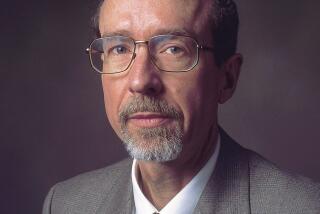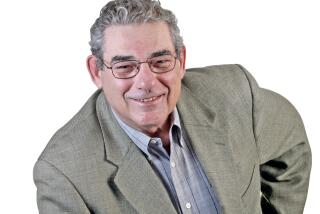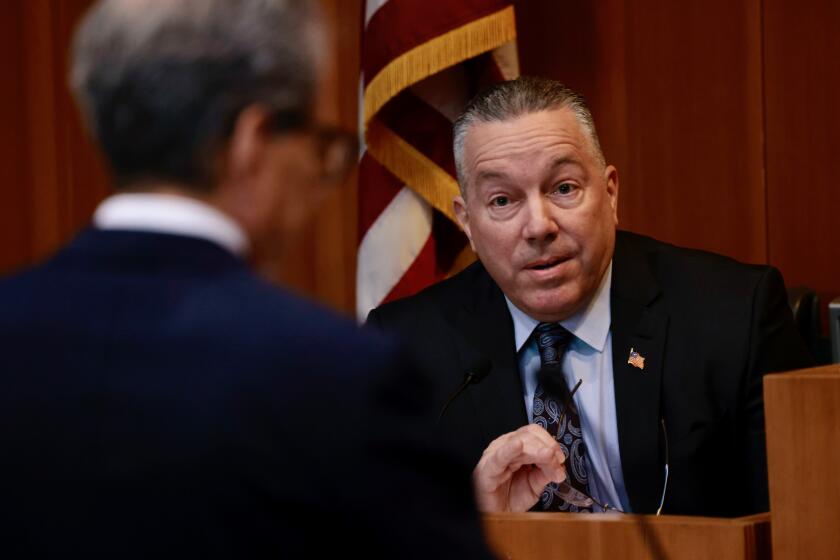Mark Fineman, 51; Longtime Correspondent for The Times
- Share via
WASHINGTON — Mark Fineman, a Los Angeles Times correspondent for the last 17 years, died Tuesday of an apparent heart attack in Baghdad while doing what he loved best -- chasing the big story and living on the edge.
Fineman, 51, collapsed at a checkpoint while waiting for an interview with a member of the Iraqi Governing Council. He was rushed to a U.S. military hospital nearby but could not be revived.
When he first felt ill, Fineman sought shelter in a small guard hut.
He then chatted with a Nepalese Ghurka sentry in broken Hindi, the legacy of Fineman’s two tours as a foreign correspondent in South Asia.
“It was classic,” said Alissa J. Rubin, a Times reporter who was with Fineman. “Mark wasn’t feeling very well and he still couldn’t stop himself from engaging.”
Fineman won or shared numerous journalism prizes during his 29 years as a journalist, including a George Polk Award, a National Headliner Award, an Overseas Press Club award and the Amos Tuck Award.
But friends and colleagues said Fineman was driven by stories, not prizes. He was tenacious, irreverent and a powerful writer who could paint beautiful word pictures. His devotion to his craft and his boyish enthusiasm for an adrenaline-filled adventure seemed embedded in his very character.
“If you think of foreign correspondents as a type, he was Exhibit A,” said John S. Carroll, editor of the Los Angeles Times. “He couldn’t bear to be away from the action. He just had an intrepid spirit. He wasn’t afraid to go where he needed to go to cover a story.”
He was competitive to the end -- crowing in an e-mail last week that he had flown from Washington to Baghdad in only 20 hours, not the two or three days most reporters need. His last front-page story appeared the day of his death -- his 795th Page 1 byline since he joined The Times in January 1986. In all, he had nearly 2,000 bylines from dozens of countries.
Shelby Coffey III, the paper’s editor from 1989 to 1997, said Fineman “had a great touch with people,” while his swashbuckling style and earthy charm gave him a “wonderful Errol Flynn persona.”
A tall, rangy man, Fineman had worn a Zapata mustache in his youth, but sported a long brown ponytail in recent years. He usually wore a denim shirt and a suede jacket. If he owned a tie, he never was seen to wear it.
Fineman’s frenetic life sometimes seemed to exclude sleep. He vowed to slow down when he transferred to the paper’s Washington bureau early last year after two decades of virtually nonstop travel -- especially after he was treated several times for cardiovascular illness. He appeared to only temper his vices, however.
Born in Chicago, Fineman studied journalism and philosophy at Syracuse University. After graduating in 1974, he returned to Chicago for a series of jobs at several papers, including the Chicago Sun-Times. In 1978, he moved to the Allentown Call-Chronicle, and three years later, to the Philadelphia Inquirer.
There, he quickly found his calling -- writing front-page exclusives. A year later, he was sent to India as one of the Inquirer’s first foreign correspondents. It was a time before computers, cell phones or CNN.
“Fineman seemed to come to full form at 3 or 4 in the morning, hovering over a telex machine with a Kingfisher beer in one hand and a cigarette hanging out of his mouth,” recalled Rone Tempest, a Times reporter who was then posted to India. “He was tireless, absolutely tireless. Just being around him was fatiguing.”
When Fineman joined The Times in 1986, he was immediately dispatched to Manila to cover the fall of Ferdinand E. Marcos’ regime. Alvin Shuster, then the foreign editor, remembers Fineman’s first reports as “remarkable.”
“He wrote the saga of the last days of Marcos, a story so compelling that it was used across the top of Page 1,” Shuster said. “I’ve never seen that again.”
In 1989, the paper moved Fineman back to New Delhi. Steve Coll arrived the same year on his first overseas assignment for the Washington Post.
“I didn’t know anything about being a foreign correspondent and he was generous from the first day,” recalled Coll, now the Post’s managing editor.
“He really taught me ... how important it was to go and see it yourself.”
Once, Coll said, Fineman figured out how to cover bloody riots in Kashmir when it was too dangerous to drive or walk.
“Mark came up with the idea of covering the shootings and the riots on bicycles.... So we did.”
When Pakistan’s then-prime minister, Benazir Bhutto, flew to Washington to address a joint session of Congress in 1989, Fineman was one of two Western journalists invited along. And when Saddam Hussein invaded Kuwait in August 1990, Fineman was the first American print journalist into Baghdad. Two years later, he was one of the few reporters who stayed in Kabul when fierce combat engulfed the Afghan capital.
“The rockets were coming in, and Mark just had this manic sense of humor, which is just what you need at a time like that,” recalled Gary Thomas, a Voice of America correspondent. “In situations like that, you travel with buddies to watch your back. And Mark was the rock.” When the Soviet Union collapsed after a coup attempt in 1991, Fineman’s editors sent him to Moscow.
“There’s nobody better to have around when a country is collapsing than Mark Fineman,” said Michael Parks, a former Moscow bureau chief and editor of The Times who is now director of the USC Annenberg School of Journalism. “He had a sense for the drama of the moment. But he had a way of telling it for the people.”
Fineman’s work also spotlighted the plight of the poor and the ignored. Robert Nickelsberg, another longtime friend and Time magazine photographer, said Fineman “would empathize with them. He had a soft spot for the down and out. He identified with the underdog.”
While in India for The Times, Fineman met his second wife, Michelle Prosser. They wed in a simple ceremony in New Delhi, and later moved to his subsequent postings as Middle East bureau chief in Nicosia, Cyprus, from 1992 to 1994, as Mexico City bureau chief from 1994 to 1997, as Caribbean bureau chief from 1997 to 2002, and as a Washington correspondent covering campaign finance and other issues last year.
Fineman said recently that the happiest day of his life was this year, when he presided over the wedding of his stepdaughter, Harmony Little, a resident of Lexington, Ky. His stepson, Sebastian Hulthen, lives in Stockholm.
Fineman also is survived by his mother, Juanita Fineman, of Highland Park, Ill., and a brother, Glen Fineman, of Omaha.
The U.S. Air Force is repatriating Fineman’s remains from Baghdad to Dover Air Force Base in Delaware. Arrangements for his funeral and a memorial service were pending.
A memorial fund has been established at a nonprofit group that defends endangered journalists around the world. Contributions can be sent to the Mark Fineman Fund, c/o The Committee to Protect Journalists, Development Dept., 330 7th Ave., 12th Floor, New York, NY 10001.
More to Read
Sign up for Essential California
The most important California stories and recommendations in your inbox every morning.
You may occasionally receive promotional content from the Los Angeles Times.











